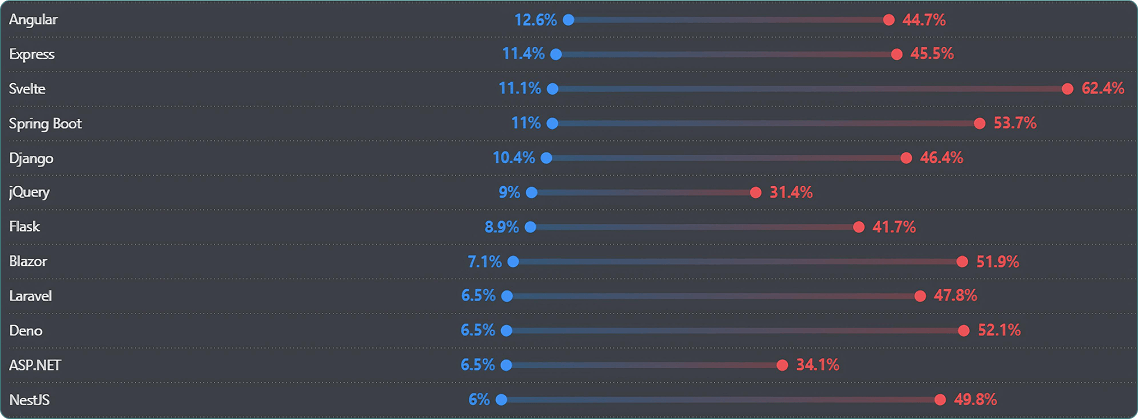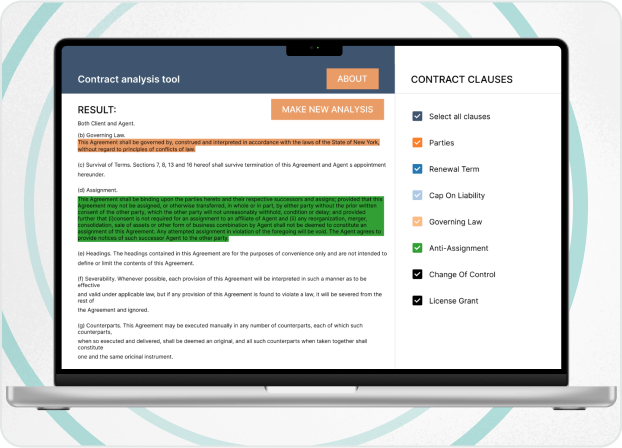
Expert’s Thoughts

"It’s hard to believe that in the industry of software development anybody has never encountered JavaScript. There are also very few programming languages that can challenge or even overrun it by popularity. In addition, developers work with dozens of JavaScript frameworks in numerous projects, and each framework is unique and best suited for specific tasks.
Silk Data’s blogpost is an overview on the most popular frontend and backend JS frameworks with the criteria of what should be considered while applying to any of them."
Yuri Svirid, PhD. — CEO Silk Data
JavaScript Development Industry Insights
In the first quarter of 2025 Stack Overflow presented their annual development survey dedicated to the tools and technologies currently used by software developers.
The survey was conducted among 25 000 professional developers and around 50 000 respondents in total with the results are the following:
JavaScript remains the most popular programming language with almost 69% of respondents using it on a regular basis. It has been occupying this position every year since 2015.

Source: https://survey.stackoverflow.co/2025/technology#admired-and-desired
JS is both one of the most desired (34%) and admired (47%) programming languages , being overrun by Python only. However, these numbers significantly differ from those of the previous year (40% and 58% respectively).
- Around 20% of PHP developers and 14% of Java developers want to start working with JS.
Despite being far from the most well-paying programming languages ( 64 000 USD/year compared to 90 000 USD for Ruby or 76 000 for Rust and Go ), JavaScript remains one of the most demanded by business.
The key reason is that JS has recommended itself as a leader and a ‘must-have’ tool for web developers. Most of the businesses require websites for activity and online promotion. JavaScript makes these websites and web apps available on all browsers and platforms, while numerous JS-based libraries and frameworks ensure both backend and frontend development.
However, the question is which frameworks are the best and what are the factors that define it. In this blogpost we’ll consider the 5 frontend and 5 backend most popular JS frameworks and libraries along with some additional tools that are worth mentioning.
Frontend JS Frameworks

React
React is a JavaScript library developed by Facebook (now Meta) in 2011 as a prototype on Facebook’s News Feed and finished as an open-source project two years later.
For the past dozen of years React has gone through 19 major version releases and become the most popular JS-based frontend development tools.
The State of JavaScript 2024 report indicates that among more than 13 000 professional JS developers who responded to the survey’s questions, 82% used React at least once in their career. The report also provides the following numbers:
- 35% level of professional interest.
- 76% level of usage satisfaction.
- 40% level of appreciation.
Furthermore, the statistics say that among 13,000 respondents 8 500 (67%) use React at work.
React’s extreme popularity is a logical result of several positive features appreciated both by frontend developers and by companies who work with them. These are:
- Virtual DOM. The feature that enables efficient and smooth UI updates. The in-memory data structure that allows the web browser to calculate the rendering needs and render only the changed UI elements instead of the whole UI.
- React Hooks. React-specific utilities that use functions, allowing the developers not to dive deep into classes and rewrite the same code multiple times. It provides cleaner code structure and quicker web app optimization.
- JSX. An extension for JavaScript syntax that uses the same writing logic as HTML does. An appreciated combination of JS development logic and convenient HTML writing.
A thorough overview of all these features was conducted in one of the previous blogposts dedicated to best frontend frameworks on JS.
Nevertheless, the library still possesses several weaknesses.
- Limited built-in state management. React's basic state management tools become inadequate and difficult to optimize for controlling multiple components in large-scale applications.
- Lack of core features. Essential features for modern web development, such as routing (for navigation between views) and advanced form handling, are not included and require integrating additional third-party libraries (React Router, Formik).
- Complex initial setup. Achieving a fully functional and optimized application often requires complex extra configurations beyond the core library, adding significant initial setup complexity.
Despite the above-mentioned cons, React is still widely used. Websites like Facebook, Instagram, Twitter, Netflix and Pinterest are developed with the usage of React.

Vue
Vue is an open-source JS framework developed in 2014 by an Angular developer who wished to have all the positive parts of Angular but make the solutions lightweight.
The State of JavaScript report provides the following statistics based on the data from 13 000 professional JS developers:
- 51% of them have used it at least once for their career.
- 48% level of professional interest.
- 87% level of usage satisfaction.
- 38% level of appreciation.
Even though Vue is not so widely used as React (31% usage compared to 67% respectively), it is still one of the most popular and appreciated frontend frameworks for 2025 projects. It is the outcome of various positive features implemented into framework:
- Reactivity system. The mechanism with the purpose same to the React’s virtual DOM but with the different working principle. It allows to update the UI whenever necessary with optimized performance.
- Routing. Vue’s routing provides the update of the required web page parts without the full page reload. The feature positively effects user experience, enhancing the web product’s working speed.
- Templates. The feature that allows to contribute standard HTML with dynamic behavior which positively affects the website or web app’s UI.
However, Vue also has some negative sides that make it inappropriate for some projects.
- Limited third-party ecosystem. The number of available plugins, tools, and integrations is more limited compared to larger frameworks, making it harder to find pre-built solutions for specific tasks. The smaller ecosystem can slow down the development process when developers must build custom solutions instead of leveraging existing ones.
- Structural inconsistency. The framework's flexibility and lack of strict conventions can lead to inconsistent code structure and architecture across different projects.
- Steeper learning curve for beginners. The freedom and lack of enforced patterns can be confusing for inexperienced developers, potentially leading to more time spent deciding on implementation approaches.
Nonetheless, Vue is a widespread and still efficient tool for web development, as there are many websites and web applications based on it, including the above-mentioned Stack Overflow, Zoom and Upwork – the most popular freelance platform in the world.

Angular
Another giant of JavaScript frontend development industry created by Google in 2016.
The State of JavaScript report indicates that Angular shares the second place in popularity with Vue, as 50% of the respondents have used it at least once. The other insights on the popularity and common acceptance of this open-source TypeScript-based framework are the following:
- 17% level of professional interest.
- 54% level of usage satisfaction.
- 36% level of appreciation.
The features that make Angular one of the most popular web development frameworks are the following:
- Two-way data binding. A feature that provides real-time changes without manual DOM updates thanks to the mutual data transfer between the view and model entities.
- A built-in dependency injection system. Developers can easily put additional implementations into the system without breaking it down. In addition, the testing process becomes safer and easier, as you can isolate separate components from the entire app.
- Angular CLI. A special command-line program that provides code generation, project skeleton building functions and production-ready builds.
As framework weaknesses many companies and developers highlight the following:
- Verbose and heavy. The ‘batteries-included’ design leads to more boilerplate code and larger final bundle sizes compared to lighter frameworks.
- Slower evolution. Being backed by Google, the framework prioritizes stability and backward compatibility, which can make it seem slower to adopt new web trends than its competitors.
- Rigid structure. Its opinionated architecture ensures consistency but can feel inflexible and too complex for smaller projects or simpler use cases.
Despite all its weaknesses and some excessive complexity, Angular is a JS framework used by Forbes, YouTube, PayPal and many other smaller and larger websites and applications.

Svelte
Svelte was developed in 2016 as an open-source frontend framework and was quickly and easily adopted by the JavaScript development community.
Stack Overflow’s 2025 Developer Survey indicates that despite the rather limited number of professional developers using Svelte on an everyday basis, the framework demonstrates 62% level of admiration , which makes it one of the most highly admired technological frameworks.
In addition, the State of JavaScript report presents the following numbers:
- 26% of JS developers have used Svelte at least once for their career.
- 65% level of professional interest (the highest of all JavaScript libraries and frameworks).
- 88% level of usage satisfaction.
- 22% level of appreciation.
The same source demonstrates that Svelte is the next most popular tool in corporate development after React, Angular and Vue with around 11% of respondents using it.
The increased popularity of Svelte is a result of several beneficial features it has:
- No virtual DOM. Instead of updating components through a digital ‘mediator’ which the virtual DOM is, Svelte compiles components into optimized JavaScript that surgically updates the DOM only where needed.
- Good SEO positioning. The fact that Svelte encourages minimal runtime wrappers and absence of VDOM-based web app’s optimization means that search engines see fully rendered HTML, and fast pages are better ranked.
- Lightweight. As Svelte works with real DOM only, the hardware get far less workload, while downloads and updates go as smooth as possible.
At the same time, Svelte has disadvantages as well.
- Smaller ecosystem. Has fewer third-party libraries, UI components and integrations compared to larger frameworks, which can require building solutions in-house.
- Smaller community. A relatively smaller professional community means less available expertise, learning resources and slower problem-solving for complex issues.
- Corporate backing concerns. While open-source, Svelte’s evolution is less driven by a tech giant, raising long-term sustainability questions for some businesses compared to Google's Angular or Meta's React.
- Young tooling. Its compiler-based approach is innovative but newer, so some supporting development tools and IDE integrations are not as mature or feature-rich as those of prominent frameworks.
Nonetheless, Svelte was successfully used for The New York Times, Spotify, IKEA and many other famous business websites and web applications.

Solid.js
One of the youngest JS entities, Solid was released in 2020, as a framework for UI development. According to the State of JavaScript report, Solid was used by fewer than 1 in 10 professional JS developers in 2024. The other statistics shows the following data:
- 54% level of professional interest (second after Svelte and higher than of any more famous framework).
- 90% level of usage satisfaction (the highest of all JS frontend frameworks).
- 35% level of appreciation.
The framework’s main advantage is the absence of virtual DOM (like in Svelte), which only benefits to its main purpose of building user interfaces as quickly as possible. One more strength is JSX compatibility which provides easy code migration from React-based projects.
Backend JS Frameworks

Express
Express is a backend web development framework released in 2010 and specially designed for building web applications and APIs.
The framework appears to be one of the most widely used backend tools, taking the sixth position in the Stack Overflow list with more than 20% of respondent professional developers using it.

Source: https://survey.stackoverflow.co/2025/technology#admired-and-desired
Such a high level of adoption is explained by a number of positive features.

Routing system
Express's routing system is a mechanism that matches the client HTTP requests with the right server logic. When the match is found the system provides the right response to the request. It stands out to most 'competitors' thanks to middleware integration (as it allows to optimize the system's work with tasks requiring multiple routes) and other functions that promote flexibility and scalability.
For example, you can choose and connect to any database driver you need (MongoDB, PostgreSQL), apply ready-to-use libraries for authentication (JWT, OAuth, Sessions) and work with any frontend templates (EJS, Pug, React SSR). It also doesn't define the structure of your project (you will see no folder layouts) and the way the code should be written. In essence, Express provides the HTTP server, the developer chooses the rest.

HTTP helpers
These are built-in methods that streamline working with requests and responses. In doing so, they abstract module complexities, making the code more readable.
- Response helpers. Send responses with appropriate headers and formatting (JSON, HTML, Strings), set HTTP statuses or redirect responses to another URL.
- Request helpers. Simplify requests data extraction through quick access of route parameters and URL query strings parsing.
- Specialized helpers. Aimed at HTTP headers and cookies setting.

Asynchronous programming
The fact Express.js is built on Node.js development environment implies Express handling asynchronous operations (like database queries or API calls) without blocking the server.
It distinguishes Express from, let say, Flask (Python-based framework), where each API call, database query or file processing blocks the entire server until they are finished, allowing to process only one request at a time.
The feature of the server still able to handle other requests while waiting for asynchronous operations to be finished is one of the key reasons defining the Express’s speed, flexibility and high level of maintainability.
- Decision overhead. Its flexibility forces developers to research and choose libraries for essential features (like authentication ORMs), slowing down initial development speed.
- Middleware reliance. Complex functionality depends on integrating third-party middleware, introducing potential security risks and maintenance overhead, if packages become outdated.
- Error handling complexity. Asynchronous code and layered middleware can make debugging and unified error handling implementation more challenging.
Nonetheless, the well-known flexibility of Express has made it a working horse for companies like Uber and IBM, and many others are adopting it to reinforce the existing corporate technological systems (for example, PayPal). In essence, some developers believe that there’s hard to be a worthy opponent for years yet.

Nest.js
Another web framework based on Node.js environment. It was developed by Kamil Myśliwiec in 2017, who took his inspiration from Angular and decided to create a framework with architecture based on Express.
Despite having a shorter history than its inspirers, Nest has quickly gained popularity. Stack Overflow report indicates that by level of developers’ admiration the framework overrun both Angular and Express (49.8% against 44.7% and 45.5% respectively).

Source: https://survey.stackoverflow.co/2025/technology#admired-and-desired
Such a high admiration rate is the result of several implemented features:
- Advanced middleware. Nest is based itself on Express's middleware, but it provides more advanced technology or dependency injection architecture. In fact, Nest is capable of automatically injecting pre-built instances into the middleware. This feature is crucial for large-scale, enterprise-grade applications.
- Guards. Special class with the main purpose of determining whether a given request will be handled by the specific route handler. To access the particular route handler, the request should meet specific conditions, and guard checks whether these conditions are fulfilled or not. Guard can be considered as a special form of middleware with the difference that it is responsible for approving the access to specific handler (i.e. authorization) while middleware checks, if the request can be processed by any handler (i.e. authentication).
- Interceptors. Another Nest's special class that promotes execution of additional logic both before and after the request reaches the handler. Why is it beneficial? Because you don’t have to write the logic every time – it's enough to write it once in interceptor. In addition, interceptors provide enhanced control over the request/response steam.
However, there are some limitations for Nest usage.
- High complexity and verbosity. Its structured, Angular-inspired architecture introduces significant boilerplate and complexity, making it overkill for small projects or simple APIs.
- Low adaptability and migration difficulty. Integrating Nest into an existing codebase is challenging. Let’s say you have an Express-based application that you’d like to a more structured Nest framework. To do so, you’ll have to literally rewrite the whole code to align with the app’s logic.
- Performance overhead. The abstraction layer and extensive use of decorators can introduce minimal performance overhead compared to a highly optimized, bare-bones Express application.
Secondly, Nest would hardly be useful in small projects. The necessity of working with guards, handlers, interceptors and other classes and methods make the development more complicated, while Express can provide the same results with simple ‘app.get()’ and ‘res.send()’ entities. This fact makes Nest an inappropriate choice for simple prototypes, proof-of-concepts or minimal APIs.
Through that, Nest is used in sophisticated websites and applications like those of Adidas, Mercedes-Benz and BMW.

Fastify
One more web backend framework for Node.js that was developed and released in 2016. It has a rather limited sphere of usage as no more than 2-3% of developers on average use it at the professional level. However, it has the same level of admiration as Nest does (49.7%) and such a great level of satisfaction is achieved thanks to several positive features.
- Superior performance. Fastify was designed from the ground up for maximum speed and low overhead, making it one of the fastest web frameworks available for Node.js.
- Schema-based validation. Built-in JSON Schema validation automatically handles serialization and request/response validation, increasing security and reducing boilerplate code.
- Developer friendly. Offers an expressive and intuitive API, excellent logging, and a powerful plugin ecosystem for easy and modular application development.
- Highly optimized. Features like smart, JSON-based logging and built-in support for async/await contribute to both high performance and a clean development experience.
However, fewer plugins and community resources compared to most other frameworks can be repelling, as they raise the problem of slowed and non-productive development.
Despite this, Fastify has been used even by some large companies for their web products, including Walmart and American Express.

AdonisJS
AdonisJS is a full-featured, TypeScript-based web backend framework for Node.js. It was released in 2015, inspired by Laravel (PHP web framework) and provides similar development experience.
Its main strength (and the feature adopted from Laravel) lies in a structured MVC pattern. It is based on three main components – view, model and controller. As they sound like Angular’s two-way binding components, they are totally different. The difference is that in Adonis they are specially tailored for backend part of web applications.
- Model is a class that represents a database and runs on the server.
- View is a template file that is rendered on the server into HTML and then sent to the client.
- Controller is a class that handles HTTP requests on the server, interacts with models and renders views.
Altogether, they make the product’s code more maintainable, scalable and ‘accessible’ for testing , because each component is responsible for its functional part only (models handle data, views handle visual presentation and controllers handle the whole application flow). Moreover, the Model-View-Controller pattern defines the structure and standardizes web app’s logic , which reduces decision fatigue and makes large codebases easy to navigate.
Apart from basing on MVC, Adonis is a full-featured framework which means that it comes with authentication, ORM (object-relational mapping) and routing.
Nonetheless, all these benefits come with trade-offs, such as excessive weight and load on the system (if compared with Express and the others) along with sufficient learning curve (because of the complexity of its conventions).

Hono
Hono was created by Japanese software developer Yusuke Wada in 2021. The motivation for the product’s release was the fact that existing Node.js frameworks like Express were not suitable for the edge environment.
- Highly portable and standard-based. Uses Web Standard APIs, allowing the same codebase to run seamlessly on Node.js, Deno, Bun and edge platforms like Cloudflare Workers.
- Built-in convenience. Key helpers (like URL pattern matching and convenient response methods) are available out-of-the-box on every request, reducing initial setup and configuration.
- Extremely lightweight. Offers a minimal footprint and exceptional performance, crucial for serverless and edge functions where cold start time is a key metric.
However, for the moment of mid-2025 Hono remains a rather young framework, which implies limitations and development barriers for some projects.
- Small ecosystem. As a newer framework, it has a much smaller community, fewer third-party plugins, and less learning material compared to established giants like Express.
- Edge-focused specialization. Its core design is optimized for edge or serverless runtimes, which can make it less feature-rich or unnecessarily complex for traditional, monolithic backend applications.
- Limited middleware. While growing, its collection of compatible middleware is not as vast or battle-tested as Express's, potentially requiring custom solutions.
A Couple More JavaScript Frameworks

Next.js
Next.js was released in 2016 as a React framework aimed to sidestep problems of building web apps with React. This primarily refers to potential security and SEO issues and extended page loading time. To avoid these problems Next.js relies on several features.
- Server-side rendering. Pages are rendered on the server for each request. This sends a fully populated HTML page to the browser, improving SEO and ensuring users see content immediately, even before React hydrates interactivity.
- Page-based routing. The file system is the router. Files in the ‘pages/’ or ‘app/’ directory automatically become routes. This eliminates complex configuration and enables automatic code splitting for optimal performance.
- Static site generation. Pages are pre-rendered to static HTML at build time. These files can be served globally via a CDN, resulting in the fastest possible loading times and reduced server load.
- Incremental static regeneration. It is a hybrid approach which implies that statically generated pages can be updated in the background after deployment. You can revalidate and regenerate pages on a per-page basis without a full rebuild.
Altogether these features make Next.js extremely popular among the developers. The Stack Overflow report indicates that the framework is used by at least every fifth developer (21.5 % of respondents) , being overrun by React and Node.js only. That’s why, according to the latest reports, the framework is widely adopted by corporations like Nike, Netflix and TikTok.

Koa
Koa was created by the team behind Express, notably lead developer TJ Holowaychuk, and released in 2013. The motivation for its release was to address the architectural limitations of Express itself, particularly its reliance on callback-heavy middleware.
If we’d like to distinguish the framework from Express, we should first note its modernized use of asynchronous code. Koa is built around native ES6 async/await functions. These functions are a syntactic feature built into modern JavaScript engines that allows to write asynchronous code that looks and behaves like synchronous code.
For web development, the feature eliminates callback necessity and provides vastly superior error handling. This means working with Koa provides a more elegant and composable middleware stack where control flows down and then back up the chain, while Express handles middleware in a more linear and less flexible way.
One more issue is that Koa offers a more minimal and refined core. It bundles no middleware within its core module, providing only a robust set of methods that make writing servers enjoyable. This contrasts with Express, which includes router and static file-serving middleware, requiring developers to deactivate what they don't need.
However, Koa's minimalist philosophy is also its main drawback for some. Its extremely small footprint means common functionalities like routing or body parsing require the installation of separate, third-party middleware libraries. This necessitates more initial configuration and research than the more batteries-included Express, potentially leading to fragmentation as developers must assemble their own tailored toolkit.
What does Define Good Framework in 2025?

Performance and Efficiency
In 2025 performance and efficiency go beyond raw speed – the main idea is to provide intelligent resource utilization. It implies practices like advanced techniques like compile-time optimizations, minimal JavaScript bundles and efficient hydration strategies for web applications.
For developers and businesses, this means frameworks that excel not just in benchmarks but lead to better user engagement and SEO.
Efficiency also extends to the backend, with powerful caching mechanisms, support for modern protocols and cost-effective operation on edge networks or serverless platforms. A framework that doesn’t prioritize a lightweight footprint and fast execution will hinder both user experience and business metrics in an increasingly competitive digital landscape.
To this category we can refer Hono, Solid, Svelte and Fastify.

Versatility and Flexibility
The ideal 2025 framework should act as a unified foundation for a project’s entire lifecycle. It must seamlessly support multiple rendering patterns (like SSR, SSG and ISR), allowing developers to choose the right strategy for each page.
The framework’s flexibility will be evident in its ability to power everything from marketing sites and blogs to complex dynamic applications and APIs within a single project. This avoids the need to stitch together different technologies. Furthermore, it won’t lock developers into a specific backend service or deployment target, offering instead a modular architecture that can adapt to new tools and paradigms, ensuring long-term viability and avoiding vendor lock-in.
Frameworks like React, Express and Vue shine here the most.

Developer Experience and Ease of Use
A superior developer experience will be a non-negotiable feature of a leading framework. This means comprehensive and intuitive tooling out-of-the-box: a fast dev server with hot reloading, easy debugging, and seamless testing integration. It will feature a gentle learning curve with clear, well-structured documentation and guides.
For advanced developers, it must offer powerful abstractions that automate complex tasks like code splitting, image optimization, and internationalization, reducing boilerplate and potential for error. A framework that makes developers productive and efficient through thoughtful design and comprehensive tooling will naturally attract and retain a strong community.
From this point, we can recommend Vue, Svelte and Next.js.

Large Professional Community
A large, active and professional community is another critical asset. It signifies stability and long-term support for projects, as the community provides a vast ecosystem of plugins, extensions and third-party tools that extend the framework’s core functionality and make it able to solve a wider range of business tasks.
For businesses, a strong community makes technology choice easier, and it guarantees a pool of skilled talent for hiring and providing a clear signal of the framework’s maturity and staying power. As a result, it creates a cycle of innovation and support that benefits all the members of web ecosystem.
React, Angular, Vue, Node.js, Express and Next.js all can demonstrate large communities and third-party data and information sources that make development quicker and easier.
Conclusion
The JavaScript ecosystem in 2025 remains as competitive as it has been for more than a decade, offering a diverse range of frameworks tailored to different needs. From the established dominance of React and Express to the rising popularity of Svelte and Hono, each framework provides its unique strengths.
Nonetheless, the key to success lies in aligning your project’s requirements with the right tool, whether it’s React’s component-driven UI efficiency, Express’s minimalist flexibility, Nest’s structured architecture or Hono’s edge-native performance.
As the landscape evolves, factors like performance, developer experience and community support will continue to define top JavaScript frameworks. Whether you’re building a lightweight static site or a complex enterprise application, JavaScript’s versatility ensures there’s a framework perfectly suited to your goals.
If the choice is still complicated, you can apply for professional help. Silk Data has more than a decade of experience in web development from first to the last stages, working with both frontend and backend parts. Our specialists demonstrate high proficiency in dealing with most of the above-mentioned frameworks, so we’re able to provide comprehensive IT consultations and help to decide which of them can suit your project the most.
Our Solutions
We work in various directions, providing a vast range of IT and AI services. Moreover, working on any task, we’re able to provide you with products of different complexity and elaboration, including proof of concept, minimum viable product, or full product development.
























